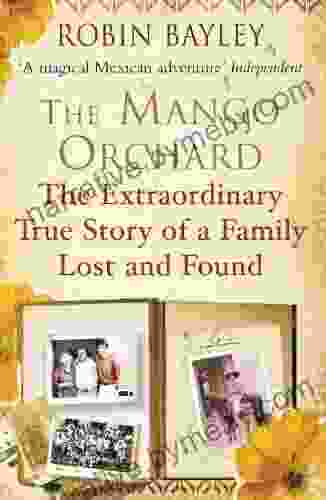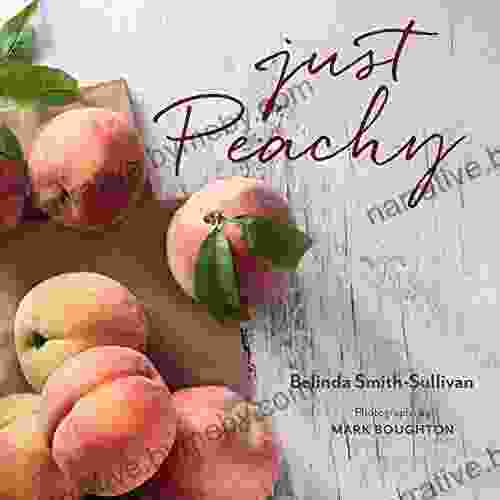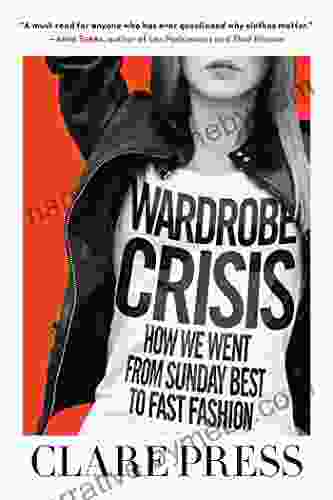How We Went From Sunday Best to Fast Fashion: The Evolution of Clothing in America

In the early days of America, clothing was a precious commodity. Most people made their own clothes, or had them made by a local seamstress. Clothing was often passed down from generation to generation, and was carefully mended and repaired. There was a clear distinction between everyday clothing and "Sunday best," which was only worn on special occasions.
4.3 out of 5
| Language | : | English |
| File size | : | 843 KB |
| Text-to-Speech | : | Enabled |
| Screen Reader | : | Supported |
| Enhanced typesetting | : | Enabled |
| X-Ray | : | Enabled |
| Word Wise | : | Enabled |
| Print length | : | 338 pages |
The Industrial Revolution brought about major changes in the way clothing was produced. Mass-produced garments became more affordable, and people began to buy new clothes more often. By the early 20th century, the concept of "fast fashion" began to emerge. Fast fashion is characterized by its low prices, trendy designs, and rapid production. It is designed to be disposable, and consumers are encouraged to buy new clothes frequently.
The rise of fast fashion has had a profound impact on the way we think about clothing. Today, clothing is often seen as a disposable commodity. We buy new clothes for every occasion, and we often discard them after just a few wears. This has led to a number of problems, including environmental pollution, worker exploitation, and a loss of cultural identity.
In her book, How We Went From Sunday Best To Fast Fashion, Elizabeth L. Cline explores the fascinating history of clothing in America. She argues that the rise of fast fashion has had a negative impact on our society, and she calls for a return to more sustainable and ethical fashion practices.
Cline's book is a well-researched and engaging look at the history of clothing in America. She provides a wealth of information on the subject, and she does so in a way that is both accessible and thought-provoking. How We Went From Sunday Best To Fast Fashion is a must-read for anyone who is interested in fashion, history, or sustainability.
The Sunday Best
In the early days of America, clothing was a sign of status. The wealthy wore fine clothes made from expensive fabrics, while the poor wore simple clothes made from cheap fabrics. Clothing was also used to express one's religious beliefs. Puritans, for example, wore plain and modest clothing, while Quakers wore simple and functional clothing.
The concept of "Sunday best" emerged in the 18th century. Sunday best was a special outfit that was worn only on Sundays and other special occasions. Sunday best was often made from the finest fabrics that one could afford, and it was carefully tailored and pressed. Wearing Sunday best was a way to show respect for God and for the community.
The tradition of Sunday best continued into the 19th and 20th centuries. However, as mass-produced clothing became more affordable, people began to buy new clothes more often. This led to a decline in the importance of Sunday best. Today, Sunday best is still worn by some people, but it is no longer as common as it once was.
The Rise of Fast Fashion
The term "fast fashion" was first used in the early 20th century to describe the rapid production of trendy and affordable clothing. Fast fashion is designed to be disposable, and consumers are encouraged to buy new clothes frequently.
The rise of fast fashion has been driven by a number of factors, including the globalization of the textile industry, the development of new technologies, and the increasing demand for affordable clothing. Today, fast fashion is a global industry worth billions of dollars.
Fast fashion has had a profound impact on the way we think about clothing. Today, clothing is often seen as a disposable commodity. We buy new clothes for every occasion, and we often discard them after just a few wears. This has led to a number of problems, including environmental pollution, worker exploitation, and a loss of cultural identity.
The Impact of Fast Fashion
The rise of fast fashion has had a number of negative consequences, including:
- Environmental pollution: The production of fast fashion garments requires a great deal of energy and resources. The textile industry is one of the largest polluters of water and air in the world.
- Worker exploitation: Fast fashion garments are often produced in developing countries, where workers are paid low wages and work in dangerous conditions.
- Loss of cultural identity: Fast fashion promotes a globalized and homogenized culture. It discourages people from expressing their individuality through their clothing.
The negative impacts of fast fashion are becoming increasingly apparent. Consumers are becoming more aware of the environmental and social costs of fast fashion, and they are beginning to demand more sustainable and ethical fashion options.
A Call for Change
Elizabeth L. Cline argues that we need to move away from fast fashion and towards more sustainable and ethical fashion practices. She calls for a return to the values of the past, when clothing was made to last and was cherished by its owners.
Cline offers a number of suggestions for how we can create a more sustainable and ethical fashion system. These suggestions include:
- Buy less clothing: The most sustainable way to reduce the impact of fashion on the environment is to buy less clothing. Only buy clothes that you really need and that will last.
- Buy quality clothing: When you do buy clothes, invest in quality pieces that will last for years to come. Avoid buying cheap, disposable clothing.
- Support sustainable brands: There are a number of brands that are committed to sustainable and ethical fashion practices. Support these brands by buying their clothing.
- Repair and recycle your clothing: When your clothes get damaged, repair them instead of throwing them away. You can also recycle your old clothes by donating them to charity or by selling them online.
By following these suggestions, we can help to create a more sustainable and ethical fashion system. We can also help to preserve our cultural heritage and to reduce the impact of fashion on the environment.
How We Went From Sunday Best To Fast Fashion is a well-researched and engaging look at the history of clothing in America. Cline provides a wealth of information on the subject, and she does so in a way that is both accessible and thought-provoking. How We Went From Sunday Best To Fast Fashion is a must-read for anyone who is interested in fashion, history, or sustainability.
4.3 out of 5
| Language | : | English |
| File size | : | 843 KB |
| Text-to-Speech | : | Enabled |
| Screen Reader | : | Supported |
| Enhanced typesetting | : | Enabled |
| X-Ray | : | Enabled |
| Word Wise | : | Enabled |
| Print length | : | 338 pages |
Do you want to contribute by writing guest posts on this blog?
Please contact us and send us a resume of previous articles that you have written.
 Book
Book Novel
Novel Page
Page Chapter
Chapter Text
Text Story
Story Genre
Genre Reader
Reader Library
Library Paperback
Paperback E-book
E-book Magazine
Magazine Newspaper
Newspaper Paragraph
Paragraph Sentence
Sentence Bookmark
Bookmark Shelf
Shelf Glossary
Glossary Bibliography
Bibliography Foreword
Foreword Preface
Preface Synopsis
Synopsis Annotation
Annotation Footnote
Footnote Manuscript
Manuscript Scroll
Scroll Codex
Codex Tome
Tome Bestseller
Bestseller Classics
Classics Library card
Library card Narrative
Narrative Biography
Biography Autobiography
Autobiography Memoir
Memoir Reference
Reference Encyclopedia
Encyclopedia Austa Somvichian Clausen
Austa Somvichian Clausen Robert D San Souci
Robert D San Souci Vivian French
Vivian French Todd A Knoop
Todd A Knoop Graham Swift
Graham Swift Aruna Krishnan
Aruna Krishnan Felix Eshesimua
Felix Eshesimua Kandra Churchwell
Kandra Churchwell Asimina Nteliou
Asimina Nteliou Bathroom Readers Institute
Bathroom Readers Institute Arun Jagannathan
Arun Jagannathan Rosayra Pablo Cruz
Rosayra Pablo Cruz Ash Klein
Ash Klein Lesley M M Blume
Lesley M M Blume Bart Rulon
Bart Rulon Kate Spade New York
Kate Spade New York Bryan Wilton
Bryan Wilton Avery Faigenbaum
Avery Faigenbaum Beata Borucka
Beata Borucka Basudeb Bhatta
Basudeb Bhatta
Light bulbAdvertise smarter! Our strategic ad space ensures maximum exposure. Reserve your spot today!

 Edwin BlairEscape to Paradise: Uncover the Enchanting Flavors and Hidden Gems of Costa...
Edwin BlairEscape to Paradise: Uncover the Enchanting Flavors and Hidden Gems of Costa...
 David Foster WallaceThe Extraordinary True Story of Family Lost and Found: A Journey of Love,...
David Foster WallaceThe Extraordinary True Story of Family Lost and Found: A Journey of Love,... Roy BellFollow ·9.7k
Roy BellFollow ·9.7k Dallas TurnerFollow ·15.5k
Dallas TurnerFollow ·15.5k Jack ButlerFollow ·6.8k
Jack ButlerFollow ·6.8k Bobby HowardFollow ·9.4k
Bobby HowardFollow ·9.4k Fred FosterFollow ·4.5k
Fred FosterFollow ·4.5k Terry BellFollow ·8.8k
Terry BellFollow ·8.8k Cody BlairFollow ·3k
Cody BlairFollow ·3k Christopher WoodsFollow ·5k
Christopher WoodsFollow ·5k

 Ian McEwan
Ian McEwanWhy Didn't Anyone Say Anything? Uncovering the Hidden...
By [Author's...

 William Wordsworth
William WordsworthArthurian Legendarians: Faithless One - Part One – A...
In the realm of legendary tales, the...

 Corey Hayes
Corey HayesSSAT ISEE Prep Test: Arithmetic Review Flash Cards Cram...
Are you preparing for the SSAT or ISEE exam?...

 Robert Louis Stevenson
Robert Louis StevensonUnveiling the Essential Guide to Compliance: BCBS 239...
In the ever-evolving...

 Javier Bell
Javier BellJust Peachy: A Tale of Sweetness and Sassiness
Immerse yourself in a...

 Brent Foster
Brent FosterStep-by-Step Instruction Manual to Building a Real Estate...
Are you eager to embark on the...
4.3 out of 5
| Language | : | English |
| File size | : | 843 KB |
| Text-to-Speech | : | Enabled |
| Screen Reader | : | Supported |
| Enhanced typesetting | : | Enabled |
| X-Ray | : | Enabled |
| Word Wise | : | Enabled |
| Print length | : | 338 pages |








